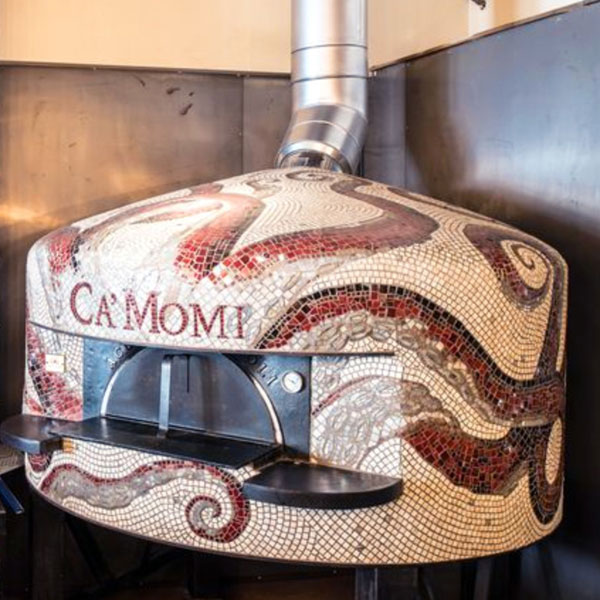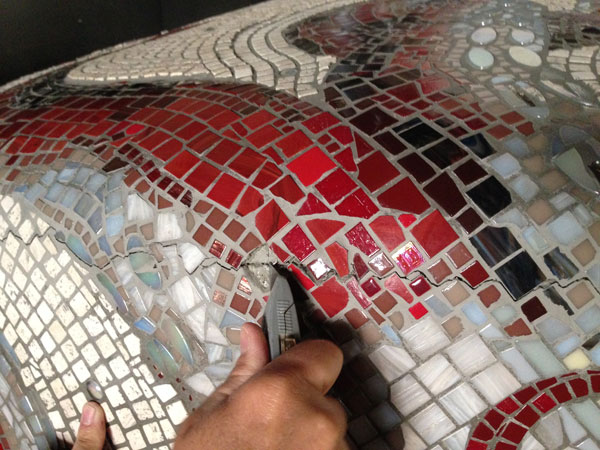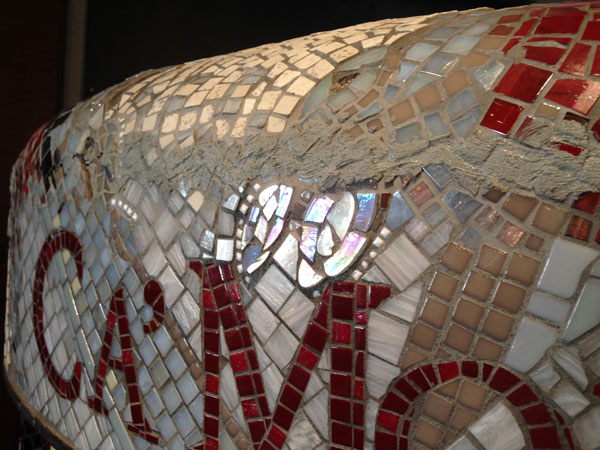Mosaic Fireplace and Oven Surrounds: The Basics
A couple of years ago, I wrote a page explaining how glass, ceramic, and stone tiles can be used for mosaic fireplace surrounds and how the tiles should be mounted with thinset mortar or white PVA (polyvinyl acetate) adhesives such as Weldbond. But we are talking about the SURROUNDS, not inside the firebox. For inside the firebox, your need to use refractory materials (brick or stone) that can resist combustion temperatures. For the hearth, the issue is not temperature resistance so much as impact resistance: It doesn’t make sense to use glass tiles that are easily cracked by a metal poker or small tiles that are easily knocked loose. Stylistic concerns should never outweigh performance and durability, else the work won’t look good for long.

Problems with a Mosaic Pizza Oven
Recently, artist Kristina Young emailed me concerning a problem she was having with a mosaic she installed on the outer surface of an Italian pizza oven. The problem was that the mosaic was cracking over the door of the oven, and that caused me some concern because that should not happen with traditional fireplaces and pizza ovens constructed with brick or stone, and I have been telling people for years that there was no reason why they could not put mosaics on these surfaces in spite of the heat. Had I overlooked some basic technical principle and made recommendations that could ruin hundreds of people’s projects? The engineer in me became completely paranoid, and I could not wait for Kristina to email me back with answers to my initial questions.
Spoiler Alert: The good news is that the cracking is reparable and that the cracking is by the iron frame of the oven door, not the masonry elements of the oven itself, which means that there is no reason to expect similar problems with traditional fireplaces and ovens that are made from all stone or brick or concrete.
The Case of the Cracking Mosaic

When Kristina first contacted me, she was concerned that the cracking might have been caused by heating the oven not long after the mosaic was completed. That is a potential issue because thinset mortar takes time to harden, and like concrete, it hardens by bonding moisture not by drying out. (Concrete, mortars, grouts, and other portland cement products will be soft and crumbly if they are dried out by heat or dried air. They need to incorporate the water mixed into them, not have it removed artificially.)
Humidify, Don’t Heat
I don’t think that the oven was heated prematurely or that premature heating caused the cracking. The crack is location specific, and if the mortar was artificially dried out before it could harden, then the problem would be seen all over the mosaic in the form of cracks and missing tiles. That being said, I would avoid heating fireplaces and ovens for several days after a mosaic has been applied to them and grouted. The usual practice is to run humidifiers near a new mosaic to protect them from AC or central heat –not build a fire under them!
Thermal Expansion
Except for the notable exception of ice, most materials expand when they are heated. (Water expands when it freezes, and that is why ice floats: it is less dense than the water beneath it.) The problem with thermal expansion is that materials expand at different rates, and metals like iron expand more rapidly than stone, brick, and concrete. Kristina had already told me that the crack started on the front of the oven just over the door, and so as soon as she sent me a picture of the oven showing that the door had an iron frame, it was obvious to me why the crack had started there: The glass and mortar mosaic expands at roughly the same rate as the brick and concrete oven underneath it, but the iron door frame and the other iron structural elements expand even faster. They push the mosaic up like a shell on the outside of the oven, and when the oven and frame cool back down and contract, the crack appears.
The Right Repair Materials
An “expansion joint” spontaneously forming in the middle of your mosaic might have most people panicking and thinking of repairing the crack with a flexible material such as caulk. Caulk is problematic because it will not age well. It will yellow and shrink and crack. It will look more and more like the synthetic material that it is, a material that looks out of place on tile, a material which does not age.
Grout could be used to fill the crack. After all, grout is the concrete product that is used to grout gaps between tiles in the first place. However, thinset mortar is a better choice because it is harder and tougher and more adhering than grout,, and it can tolerate slight displacement (movement) while grout cannot. In fact, it would have been best if the entire mosaic had been “grouted” with thinset. I suspect that heating and cooling the oven in cycles over time may cause other cracks to appear or reappear, and these should have thinset rubbed into them as needed. Hopefully any new cracks or reappearing cracks will be smaller, but in any case, thinset is better equipped to withstand the stresses of expanding and contracting than grout.

Aesthetics and Authenticity
Think of high-end restaurants in reclaimed urban warehouse spaces: the exposed beams, the plaster chipped away in places to reveal the stone walls underneath, the different architectural elements like fire doors and hoists deliberately left in place to call attention to the space’s past industrial use.
To me, one of the more interesting things you can see in the mosaics of Mexico and the Mediterranean basin are the repairs that have been made to these over the years following earthquakes and other damage. I’m not thinking of the repairs that were made in modern times by archaeologists or professional conservators sparing no expense to make the mosaic look as if the damage had never occurred. I’m thinking of repairs made in the distant past by inexpert hands or by people with limited access to materials. I’m thinking of repairs like mortar-filled voids and replacement tiles of not-quite-the-right color and how you can sometimes see a series of these inexact repairs apparently made at different times in response to different injuries. To me, these inexact repairs more than anything else give me a sense of how ancient the mosaics are and how much history they have witnessed, endured even: earthquakes, fires, wars with slings and arrows, wars with bullets and bombs.
A large part of the ethos of mosaic art is it being an enduring relic of the past. If I were wanting to design a mosaic to look like an old relic, I might consider deliberately including mortar-filled voids and cracks to simulate past damage or maybe re-mosaicing some of these regions with coarser tile. With that in mind, is a crack appearing in a new mosaic in an Italian or Mexican restaurant a problem or a windfall? I’m thinking not. I’m thinking of the kid who deliberately scuffs up his new baseball glove so that it doesn’t look the unused glove of a rookie.

Leave a Reply